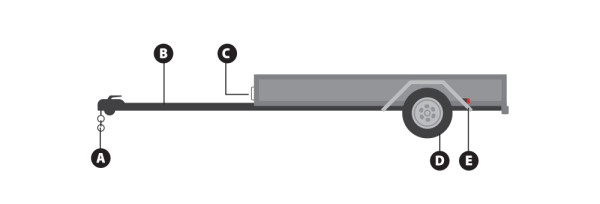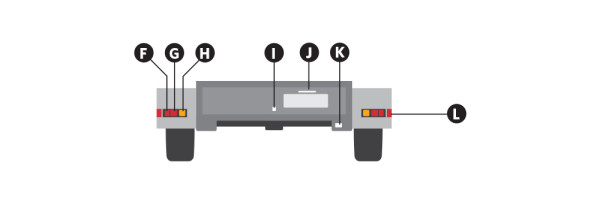There are two classes of mopeds:
There are three classes of motorcycles:
See also: Which is my vehicle class?
Your moped must meet a vehicle exhaust emissions standard if:
Except for:
|
Vehicle has to meet standard if made on or after... |
What sort of standard? |
Under what legislation? |
|
1 January 2006 |
Land Transport Rule: Vehicle Lighting 2004 |
|
|
1 January 2006 |
If fitted: |
Land Transport Rule: Vehicle Lighting 2004 |
|
27 February 2005 |
Installation standard for lighting on this class of vehicles |
Land Transport Rule: Vehicle Lighting 2004 |
|
1 October 2002 |
Land Transport Rule: Light-vehicle Brakes 2002 |
|
|
1 January 1996 |
Land Transport Rule: Vehicle Lighting 2004 |
|
|
1 January 1992 |
Land Transport Rule: Vehicle Lighting 2004 |
|
|
*The number, position and performance of lighting equipment on vehicles manufactured after 27 February 2005 must meet either an installation standard or the relevant requirements in 3.3, 4.3, 6.3, 7.3, 7.4, 7.5, 7.6, 8.3 and 9.3 of Land Transport Rule: Vehicle Lighting 2004. |
||
More information for moped riders
Your motorcycle must meet a vehicle exhaust emissions standard if:
Except for:
|
Vehicle has to meet standard if made on or after... |
What sort of standard? |
Under what legislation? |
|
1 January 2006 |
Land Transport Rule: Vehicle Lighting 2004 |
|
|
1 January 2006 |
If fitted: |
Land Transport Rule: Vehicle Lighting 2004 |
|
27 February 2005 |
Installation standard for lighting on this class of vehicles |
Land Transport Rule: Vehicle Lighting 2004 |
|
Land Transport Rule: Light-vehicle Brakes 2002 |
||
|
1 October 2002 |
Land Transport Rule: Tyres and Wheels 2001 |
|
|
1 January 1996 |
Land Transport Rule: Vehicle Lighting 2004 |
|
|
1 January 1992 |
Land Transport Rule: Vehicle Lighting 2004 |
|
|
* You may fit tyres that meet New Zealand standards to your vehicle after it arrives in the country. |
||
Here's how mopeds and motorcycles differ across a range of vehicle and driver requirements.
|
Mopeds |
Motorcycles |
|
|
Registration |
'Moped' means a motor vehicle (other than a power-assisted pedal cycle) that has— |
'Motorcycle' means a motor vehicle running on two wheels or not more than three wheels when fitted with a sidecar, |
|
Vehicle standards |
Under vehicle standards, mopeds must meet requirements of vehicle classes LA or LB. |
Under vehicle standards, motorcycles must meet the requirements of vehicle classes LC, LD or LE. |
|
Warrant of fitness (WoF) |
Aren’t required to be regularly inspected for a WoF. |
Must be regularly inspected for a WoF. |
|
Driver licence |
Riders can hold any New Zealand driver licence (eg car driver licence) to ride a moped. |
Riders must have a motorcycle driver licence to ride a motorcycle. |
Both must be designed and constructed to meet vehicle standards for lighting, brakes and tyres.
They must both be registered and licensed before you can use them on the road.
You must securely fix and clearly display the number plate at the rear of your vehicle.
You must wear an approved safety helmet.
You cannot ride motorcycles or mopeds on the footpath.
You can ride both along bus lanes and transit lanes – unless signs posted on the lane prohibit it.
It’s illegal to register a motorcycle as a moped.
It’s unsafe to drive a motorcycle without the proper driver training and driver licence.
It’s illegal and unsafe to ride either type of vehicle without an approved helmet to protect you. We also recommend you wear other safety clothing, such as protective gloves and footwear.
See more tips on motorcycle safety
Check out Ride Forever(external link), a website for motorcyclists that includes advice on road awareness.
You must not tow while you’re on a learner or restricted licence. Once you have your full licence, you can tow a light trailer (up to 3500kg when loaded).
You must take extra care when towing a trailer or another motorcycle (which must be mechanically disabled). This is because, with the extra weight behind it, your motorcycle will feel different to ride.
Follow the safe towing guidelines whenever you tow a trailer or another motorcycle.
Your trailer must have a warrant of fitness (WoF). To meet the WoF standard your trailer must be in good condition (for example, no rust around safety areas). It must have the following equipment in good working order:
A. A safe and strong coupling and a safety chain or cable.
B. A draw bar with no damage or corrosion.
C. If the trailer or its load is more than 2 metres wide, it must have 2 white lights at the front to show how wide it is.
D. Safe tyres – the tread depth must be at least 1.5 millimetres around the tyre.
E. Mudguards.

Depending on the year of registration, your trailer will also need the following features:
F. One or 2 red tail lights to show the width.
G. 2 red stop lights at the back, if the driver’s signals can’t be seen.
H. Direction indicators at the back.
I. A current trailer WoF issued by a WoF inspector.
J. A number plate light at the back.
K. A current licence label (rego) needs to be positioned close to the number plate.
L. 2 red reflectors at the back (one on each side).
The load on the trailer must not:
You must always make sure your load doesn’t create an unsafe situation for yourself or other road users.
If a load extends more than 1 metre beyond the back of your trailer, you must tie on a white flag, or a red, orange or yellow fluorescent flag during the day. At night the flag needs to be replaced with lights. The flag must be at least 40 centimetres by 30 centimetres in size. The load must be tied on firmly and must not touch the ground.